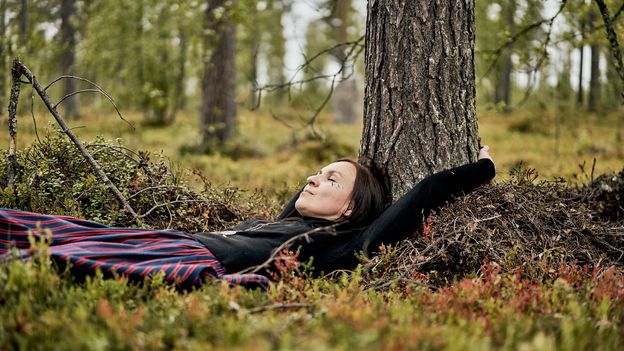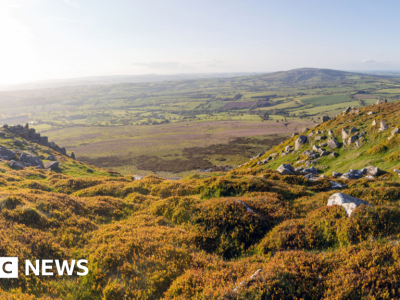In Finland’s Halipuu Forest, a family has developed a novel way to save their fragile forest: by inviting guests in to hug the trees.
N
Next summer, the fifth-annual World Tree Hugging Championships will take place in Finnish Lapland. Located around 170km north of the Arctic Circle in the private Halipuu Forest, the event challenges participants to compete in three events: first, to hug as many trees as they can in a minute, with each hug lasting at least five seconds. Second, for a maximum of a minute, to offer their most dedicated hug, showing presence, intention, love and respect to one individual tree. And finally, in the freestyle round, the contestants must give their most creative hug to a tree, however they interpret it, lasting a minute. The judges decide the winner.
Quirky though it undoubtedly is, the story and purpose behind the event has a serious meaning: it was designed to help connect people with nature, and to save a family’s forest from being chopped down.
I’m walking through that forest with Riitta Raekallio-Wunderink, who created the event with her husband Steffan. It’s winter in Arctic Finland and the sun is low in the sky in the early afternoon. The tree trunks glitter with frost as it sets, causing us to pull out our torches. As we crunch along the snowy paths, reflective silver strips – the type you might wear as a cyclist on a dark night – are wrapped around tree trunks to mark out the path ahead.
“People in the beginning found it ridiculous,” Raekallio-Wunderink said of the championships, “but not necessarily in a bad way. As Finns, we have a tendency to do silly things, you know, and don’t take ourselves too seriously. It’s more of a tradition to do crazy stuff because you want to, especially in the countryside and in Lapland. There’s space to express yourself in these kinds of ways.”
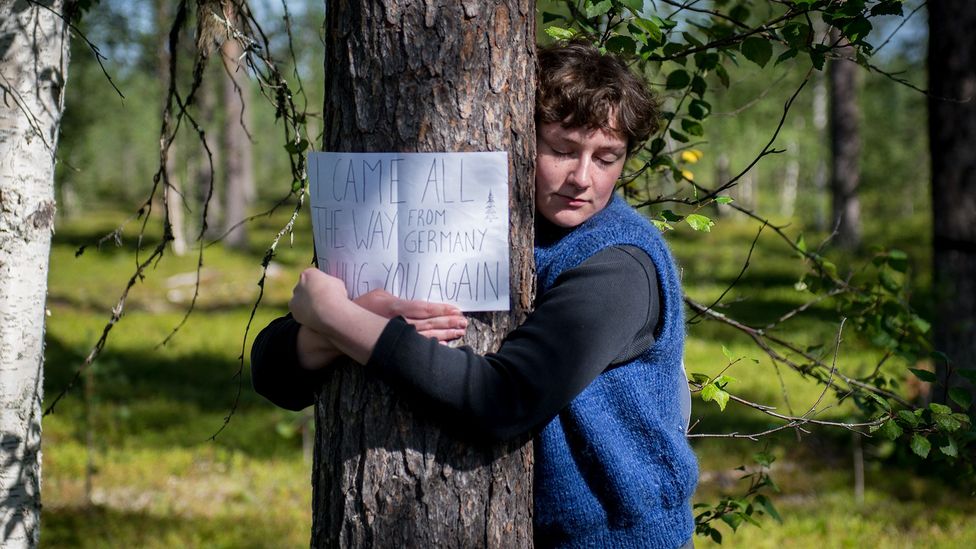
One of the events in the World Tree Hugging Championships is a hug that shows presence, intention, love and respect (Credit: Halipuu/James Thornton, Green Trek)
We stop often as we walk, to look at tracks in the snow, to feel the relative temperatures of the tree trunks and to look at various growths on the trees, including long dark-brown tendrils of an unusual type of lichen that only grows in very clean air. According to the Finnish Meteorological Institute, this area, close to the municipality of Kittilä, has some of the cleanest air in the world. As we walk further into the forest, it’s clear how connected Raekallio-Wunderink and her family are with it.
“My father started his lumberjack career here in the forest at the age of 12,” she said. “His family had moved from the north, from a part of Finland that was lost to Russia in the Second World War, when he was three, and they bought this forest and built a sawmill. He grew up in this forest. It was his playground; it was where his soul belonged. He knew this place inside out and it was really dear to him.”
Forestry in this part of the world is not an easy business. In a typical forestry cycle, you might harvest trees at anywhere between 40 and 150 years of age, but with a growing season that lasts just eight weeks in this part of northern Finland, it takes far longer, and requires much more husbandry to develop tall-enough trees. The moose that roam the forest eagerly nibble tender shoots in spring, while in the depths of winter, the sun doesn’t even rise for around six weeks. Trees that make it to full size are the ultimate survivors.
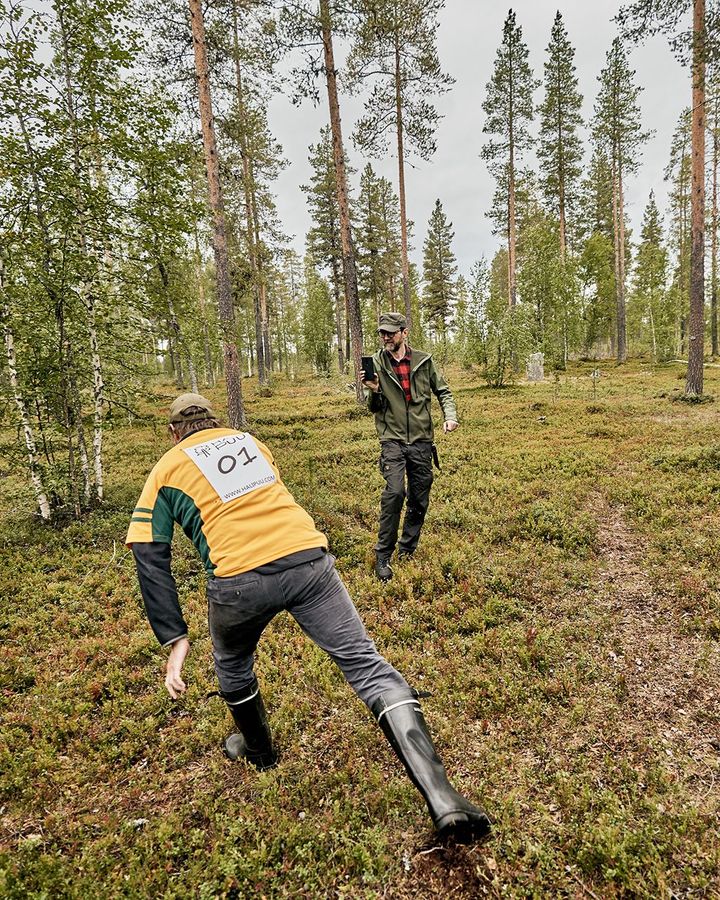
Another challenge requires competitors to hug as many trees as they can in a minute (Credit: Eat Shoot Drive)
“A few years ago, the forest had come to the end of this cycle,” she said. “It was time to cut it down and start again. Only my father didn’t want to. It was a feeling in his heart. He wasn’t able to look at it as just financial value because it had so much other value for him.”
How to get involved
You can only compete if you have won another tree-hugging championship – it’s important to protect the forest from having too many visitors – but the forest is open at other times in the year for the forest café and overnight stays.
The family started to consider how else they could keep the family business going. What other worth can you pull from a forest if you don’t extract its wood? Their thoughts drifted to offbeat ideas they’d seen elsewhere: what if they asked people to adopt trees, or even to hug them?
After walking for 15 minutes through the snow, the warm glow of a campfire shines through the trees, announcing another of their ideas: Campfire Barista, a campfire cafe. Along with Raekallio-Wunderink’s husband Steffan, we sit around the fire, toasting their home-made cloudberry and blueberry marshmallows on the flames and drinking dirty chai lattes brewed in a pot on the fire and flavoured with birch sap syrup. It’s one of the best lattes I’ve ever tasted.
A few steps from the fireplace, a fleece-lined hammock stretches between two trees, and as snow starts to fall, gently muffling the sounds around us, I climb into it and relax. The hammock is another strand to the forest preservation plan, available to guests as an Arctic Sleepover option where guests can spend the night in hammocks in the forest. The World Tree Hugging Championships were the next step.
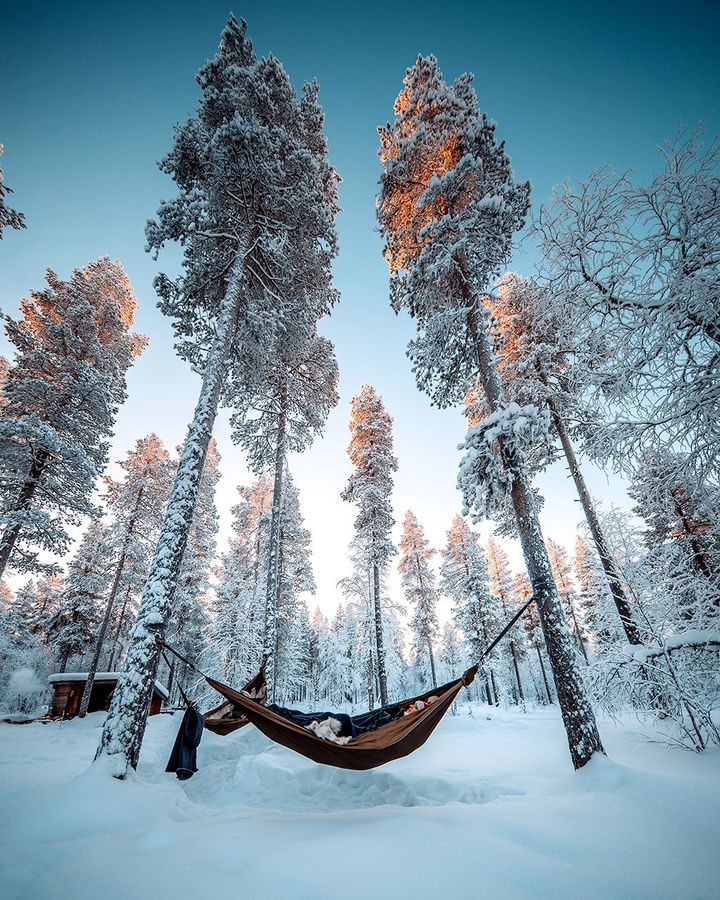
Visitors to Halipuu can also spend the night in cocooned in a hammock in the forest (Credit: Meir Schonbrun)
Following Covid, the family sensed people had a massive craving for nature after so many restrictions and lockdowns globally, and they wanted to help them reconnect. Their tree-hugging contest has been so successful that its rules have been adopted by other independent tree-hugging competitions around the world – including ones in Scotland – and the winners of these other competitions go forward to compete in the Halipuu Forest.
Behind all of it – the quirkiness of the event, the forest cafe, the adoptable trees and the cosy hammock – there’s one key driver: finding new ways to get in touch with nature, and new ways to encourage people to bond with it, following the belief that you have to experience something to love it, and love it to protect it.
It’s also a good way to get under the skin of the Finnish people: in a recent survey, more than 80% of Finnish people said the forest is important to them: it’s a place they feel at home. That’s no surprise when you consider that Finland is one of the world’s most heavily forested countries, where over 70% of its landmass is forest, and, thanks to its “Everyman’s Right” law, anyone can hike, camp and gather berries and mushrooms in a forest, regardless of who owns it.
“We offer people who come into the forest a safe way to immerse themselves in this harsh environment,” Raekallio-Wunderink said. “It’s a safe way to find the friendly face of Arctic nature – it’s quite an incredible environment. At the same time, it takes out the constant babble that people have in their heads.”
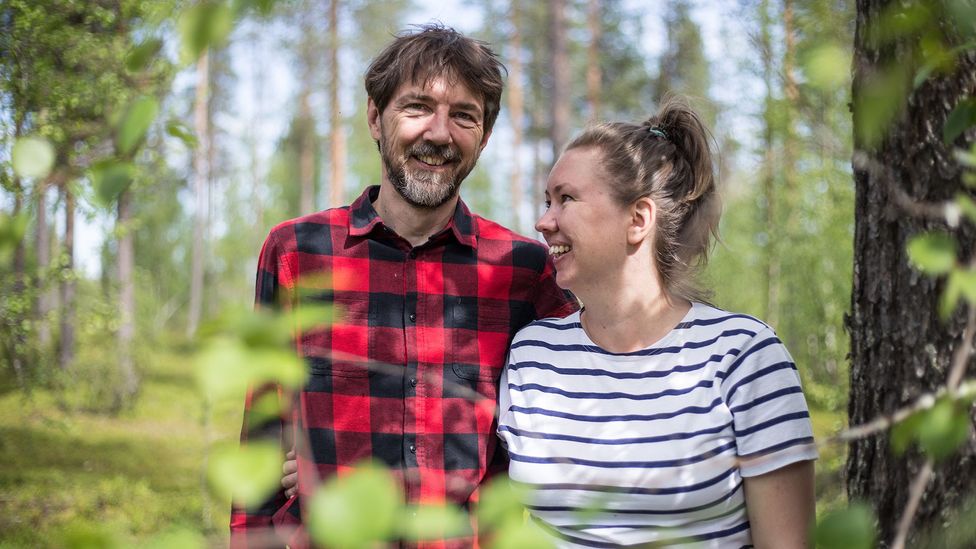
Steffan and Riitta Raekallio-Wunderink came up with the idea of hugging trees to save the family forest (Credit: Olli Autonen)
Even with this support behind it, the forest continues to need protection. Though saved from the sawmill, climate change is having an impact, with fluctuating temperatures and unpredictable weather events changing age-old patterns.
“These days, it’s not unusual to have a week of -30C followed by a week of 2C, or to experience unexpectedly heavy snow loads that damage the tree branches,” Raekallio-Wunderink said. “In the summer, things get warmer and we expect to see different types of bugs, even ones that can destroy the trees, as they come further north than before.”
What makes their tree-hugging project so effective is that it’s not just about preserving the forest: the experience gives back in equal ways, just like a hug, to its visitors too.
“In a way, we do it out of selfish reasons,” said Raekallio-Wunderink. “I like to take people into the forest and see the change that happens in them. In nature, people drop their masks. They don’t have to be something. The trees don’t judge them – they just take them as they are. For me, the most joy I get is out of seeing people change through that. I don’t think there’s enough of that feeling in the world.”
Green Getaways is a BBC Travel series that helps travellers experience a greener, cleaner approach to getting out and seeing the world.
—
Join more than three million BBC Travel fans by liking us on Facebook, or follow us on Twitter and Instagram.
If you liked this story, sign up for The Essential List newsletter – a handpicked selection of features, videos and can’t-miss news delivered to your inbox every Friday.
;

